 |
|
 |
Shahdara,
the principal entry point to Lahore from the direction of Kabul
and Kashmir, lies on the right bank of the Ravi River opposite
the city of Lahore (Brand, 1996). Mughal princes, princesses,
and important nobles built splendid gardens there. Shahdara became
a site of Mughal architectural and political activity soon after
the conquest of India by Babur in 1526. In about 1527, or one
year after the conquest of Hindustan, Babur's son Mirza Kamran
(brother of the second Mughal emperor, Humayun) built a garden
in the area. The baradari (pavilion) and some architectural
features still survive to some extent. However, the name Shahdara
first appeared in the Akbarnama in the mid-1590s in connection
with Akbar's visit to Kashmir in 1589. It is difficult today to
know the exact boundaries of the place because of the lack of
early Mughal-period textual sources. However, sources from the
sixteenth and seventeenth centuries suggest that Shahdara featured
many gardens and serais (inns) built by imperial and noble
patrons. The existence of a large number of garden sites at Shahdara
is further confirmed from a British-period map of 1867.
 |
 |
|
|
|
|
|
| |
|
The
Marble Sarcophagus
of Jahangir |
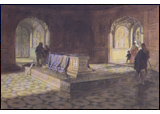 |
| |
| |
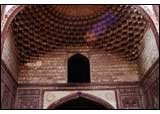 |
| |
|
Shahdara
served two functions in the early Mughal period. One was as a halting
place for the Mughal camp after crossing the Ravi along the road
from Lahore towards Kashmir, Kabul, or the hunting grounds of Sheikhupura.
The other was as a recreation zone across the river from the Lahore
citadel. Apart from Mirza Kamran's garden, Nur Jahan also built
a splendid Dilkusha ( contentment) garden in the area. Between
1527 and 1645, Shahdara experienced an extraordinary transformation
of land use, whereby its character changed from a site for pleasure
gardens to a royal funerary landscape. The royal tombs of the fourth
Mughal emperor, Jahangir (d.1627 at Rajauri and buried in the Dilkusha
garden), his brother-in-law Asaf Khan (d. 1641), and his wife, Nur
Jahan (d. 1645), were constructed within close proximity to each
other. The relationship among the three tombs and serai is unique
in that it is unmatched by that of other Mughal funerary complexes,
where one garden usually dominates the area, and the spatial relationships
among gardens are less evident.
 |
|
|
|
|
|
Kamran's
Baradari:

Kamran's
baradari stands in the midst of a formal garden built by the Mughal
Prince Mirza Kamran (son of Babur, the founder of the Mughal empire)
on the west bank of the River Ravi; it was built c.1527 and was
the earliest Mughal garden in Lahore. With the shift of the Ravi's
course, the garden site today has become an island in the river
adjacent to the bridge leading from Lahore to Shahdara. The garden
used to be a meeting place of Mughal princes. British travelers
such as William Barr and Colonel Wade also described this garden
in connection with their stay there. The garden had a number of
water features, including an eight-point-star-shaped pool. Tragically,
heavy-handed restoration work in later years entirely destroyed
the garden's status as a historical site.
|
|
| |
|
| |
|

Jahangir's Tomb:

Jahangir's
tomb was built on the site of Bagh-i Dilkusha, a garden previously
laid out by his wife, the empress Nur Jahan. The tomb was constructed
on orders from Shah Jahan after his father's death in Kashmir in
late 1627. It took ten years to complete the project. The name of
the architect is not known, but Chandar Bhan, a historian and writer
of the Char Chaman, also served as a supervisor of the site for
some time. The walled tomb-garden is entered from the Akbari serai
on the west side. The monumental entrance has extensive muqarnas
(an architectural element with niches) executed in red sandstone.
The Akbari serai has gateways on the north and south and a pre-Mughal
period mosque on the west. At the center of an approximately 600-gaz-square
garden lies the tomb building clad with red sandstone and inlaid
with marble. The tomb rests on a high podium and is surmounted with
tall minarets on all four corners. Inside, Jahangir's sarcophagus
is decorated with a vegetal pietra dura design and the ninety-nine
names of God. The dado on the walls inside the corridor is done
with tile mosaic in floral designs.
 |
|
| |
|
|
|
Detail
from Jahangir's Tomb |
|
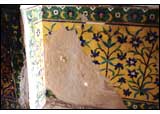 |
|
| |
|
Detail
from Jahangir's Tomb |
|
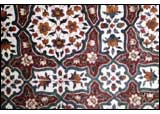 |
|
| |
|
|
|
The
square garden was divided into four parts (the chahar bagh
pattern) with water channels. There were fountains set in pools,
and water flowing over the chutes provided a dazzling effect.
Water for the tomb-garden was lifted from eight wells located
immediately outside the enclosure wall. The water was lifted by
means of Persian wheels to aqueducts running on top of the wall,
and then into terra cotta pipes feeding various fountains and
tanks. The original plantation is now gone but there are fine
fruit trees from colonial times. Today, it is a favorite picnic
spot for the city of Lahore.
Conservation
Update: The master plan for the
garden is under way. Repair of the stone fretwork on the southern
and eastern facades is now complete and work on the north facade
has begun. The brick on-edge paving on the chahar bagh’s
south walkway leading to the southern false gate is complete.
In the Akbari serai, a new water supply pipe has been laid out,
and the interior and exterior facades of the main entry gate have
been re-plastered. The Department of Archaeology has created a
master plan in which they have requested funds for the removal
of encroachments which fall within 150 feet of the perimeter wall. |
|
| |
|
| |

Asaf Khan's
Tomb:

Asaf Khan was
Jahangir's brother-in-law and governor of the Punjab at the time
of the emperor's death in 1627. When Asaf Khan died in 1641, he
held the post of Commander-in-Chief under Shah Jahan, who ordered
the construction of the tomb immediately to the west of the forecourt
of Jahangir's tomb. The extent of Asaf Khan's square garden was
set by the forecourt's 300-gaz-long western wall. It is exactly
one-quarter of the size of Jahangir's tomb. The octagonal tomb
rests in a chahar bagh with water channels and walkways. The walls
were once covered with glazed tiles and there was marble facing
on the dome. The dome has an unusual profile of the sort which
was used in the tomb of Hamza Ghaus in Sialkot.
Conservation
Update: A master plan prepared
by Dr. Abdul Rehman of the University of Engineering and Technology
was approved by the Global Heritage Fund as well as by the Department
of Archaeology. The Global Heritage Fund has had several meetings
and raised some funds for conservation.
 |
|
| Asaf
Khan's Tomb |
|
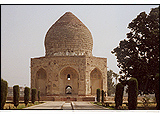 |
|
|
|
| |
|
|
|
|
|
|
|
|
|
| |
Tomb
of Nur Jahan:

Jahangir's
widow, Nur Jahan, died in 1645. She was buried to the west of
her brother Asaf Khan in a tomb she is said to have commissioned
during her lifetime. The tomb structure has since been stripped
of its stone cladding, and whatever has survived of the garden
was irreparably damaged when the British cut a railway line late
in the nineteenth century between the tombs of the two siblings.

Although no
major Mughal garden was constructed at Shahdara after the completion
of Nur Jahan's tomb, these lovely gardens still continue to play
an important role in the life of Lahore.

Crossing the River from Shahdara to Lahore Fort:

There were two main river crossings from Shahdara to Lahore. The
one near Kamran's baradari followed the modern route to the Taksali
and Roshnai gates of the Fort. The road from Shahdara town continued
due south toward the Khizri and Masti gates of the city. It has
long been supposed that a crossing existed at the Khizri gate,
Khwaja Khizr being the guide for river crossings. But the symbolic
connection between Khizr, the guide to the waters of immortality,
and the decision to locate tomb-gardens just opposite that gate
has not previously been recognized (Wensinck, 1987; Latif, 1892,
p. 86). |
|
Detail
of Nur Jahan's Tomb |
 |
|
|
|
|
|
|
|
| |
|
| |
 |
|
|
 |
|
|
|
|
|